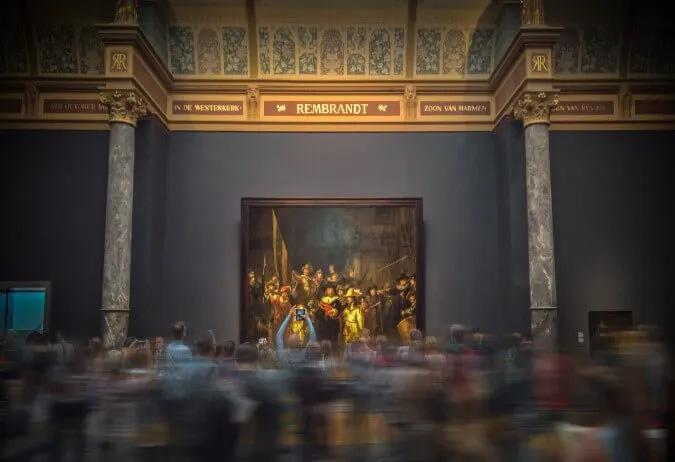We can’t wait until we can welcome you on board our Amsterdam Mini Cruises again. In the meantime, immerse yourself into our guide to the Rijksmuseum, and enjoy virtual tours which highlight all that this cultural attraction has to offer.
Located in Museum Square, within the Amsterdam South region of the city, the Rijksmuseum is one of the Dutch capital’s most popular museums. Sharing over 800 years of Dutch and global history with its visitors, the Rijksmuseum’s 80 galleries are packed full of art and artefacts which bring the past to life.
Featuring artworks from some of the Dutch greats, including van Gogh and Vermeer, this museum also boasts everything from sculptures and maritime objects to clothing and Delftware, meaning that there truly is something for everyone to enjoy. You could spend hours wandering around the delights that the Rijksmuseum has to offer, and here we share some of the highlights.
- The Night Watch

Perhaps the most famous piece in the Rijksmuseum is Rembrant’s ‘The Night Watch’. Completed by the artist in 1642, this painting is thought to have boosted Rembrant’s career, and it now sits in its own gallery in the museum where it draws the attention of everyone who visits. The painting shows the company of Captain Frans Banning Cocq and Lieutenant Willem van Ruytenburgh getting into formation, with a young girl (thought to represent Rembrant’s late wife) among the men. The captain, the lieutenant, and their 16 men paid for the painting, and you can see their names on the piece in a shield above the gate.
Rembrant used a number of different techniques when creating The Night Watch, and the painting is especially admired for its clever contrasts between light and shade. However, the piece that you can see hanging in the Rijksmuseum is not exactly how it was when it was first displayed. In 1715, the painting was taken to the Town Hall (now the Royal Palace) and four pieces were removed so that it could fit through the door! The largest section was taken from the left-hand side, with others being cut from the top, bottom, and right of the painting, and these missing pieces have never been found.
- Dolls’ houses in the Rijksmuseum
Back in the 17th century, dolls’ houses were a hobby for wealthy women rather than a toy for children, and the Rijksmuseum is home to three striking examples. One of these dolls’ houses was actually the inspiration for Jessie Burton’s popular book ‘The Miniaturist’, and belonged to a lady called Petronella Oortman who lived between 1656 and 1716. Petronella’s dolls house is made from tortoiseshell with a pewter inlay, and she spent a great amount of money commissioning pieces from leading artists and manufacturers. All pieces were built to scale using the same materials as their real-life counterparts, and this included everything from upholstered furniture to tiny crockey. Standing at two and a half metres tall and almost two metres wide, Oortman’s dolls’ house cost as much as a real house by the time she’d finished decorating it, and it was so impressive that it was even painted by a local artist.
The second dolls’ house in the Rijksmuseum was also owned by a lady called Petronella. Petronella Dunois (1650 – 1695) was an orphan who lived in Amsterdam with her sister, and one of the most remarkable things about her dolls’ house is its collection of miniature silver. The thing that makes the third dolls’ house stand out is the fact that its exterior looks like a house, whereas others were simply built to be rooms inside a cabinet. The owner of this third house is unknown, but it’s dated as being from 1760, a little later than the other two.
- The Cuypers Library

Set in the main Rijksmuseum building, the Cuypers Library is the oldest and largest art history library in the Netherlands, and one of the most impressive in the world too. Boasting as many as 450,000 volumes, the books in the Cuypers Library could stretch for 5.4km, and around 10,000 new titles are added each year too. Created in the 19th century, the Cuypers Library has been consistently collecting books since 1885, and now has a whole range of books, journals, periodicals, and catalogues for visitors, students, and art historians to browse. Books can be absorbed in the reading room, and there are iPads for completing further research too.
Of course, you don’t have to want to read about art history in order to enjoy the Cuypers Library, as the space is simply striking to look at. With tall, arched windows which allow daylight to creep in, picturesque titles, and wrought iron railings, there are plenty of decorative details around the library that will draw your attention. The books themselves are displayed from floor to ceiling over a number of storeys, and almost look like wallpaper rather than real-life book spines. The spiral staircase in the corner is also sure to attract your attention, and its details like this that make the library particularly photogenic. Although you can’t take photos in the ready room, there is a viewing gallery on the second floor from which you can take some fantastic snaps.





